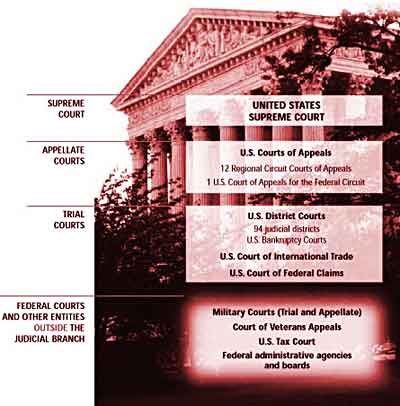Legal materials can fall into two different categories: (1) Primary and (2) Secondary. Secondary sources are about the law. They explain, analyze, interpret, discuss, and cite to primary sources. Primary sources are the law themselves. Cases are a primary source. They are judicial opinions written to resolve a controversy between two or more parties. Courts have a hierarchy and the authoritative value of a case can depend on which court is writing the opinion. Cases are published chronologically in reporters and now, in databases and on websites.

The federal court system consists of the United States Supreme Court at the top of the court hiearchy. Below the U.S. Supreme Court are the United States Courts of Appeals. There are 12 regional Circuit Courts of Appeals and the Court of Appeals for the Federal Circuit. Below the U.S. Courts of Appeals you have the U.S. District Courts. These are the trial courts. There are 94 judicial districts. At this level there are also the U.S. Bankruptcy Courts, the U.S. Court of International Trade, and the U.S. Court of Federal Claims. Congress also created several Article I, or legislative courts. These include the military courts, Court of Veterans Appeals, and the U.S. Tax Court, Not included in the judicial branch but having quasi-judicial functions are agencies and boards.
.Many, but certainly not all, appellate decisions from the courts are reported. The reported decisions are compiled by publishers (predominantly West publishing) into numbered volumes providing easy access to reported decisions. West Publishing began printing reporters in the late 1800’s and the collection became known as the West Reporter system. Prior to that time many states published their own reporter volumes and today many still publish their own reporters. West has compiled the state appellate decisions (these include intermediate appellate courts and state supreme courts) and printed them in Regional Reporters. Each region contains the decisions of several states (e.g. The North Eastern Reporter which contains cases decided by the Ohio courts also contains cases from Indiana, Illinois, New York and Massachusetts). The state published volumes are referred to as “official” reporters and the West reporters are considered “unofficial.” Most states do not publish any trial court decisions.
Unlike most states, the federal courts do publish some decisions from the trial level. The decisions, from the Federal District Courts, are printed in the Federal Supplement reporter. The appellate decisions, from the Federal Circuit Courts, are printed in the Federal Reporter. Both of these reporters are considered “official” because there is no other comprehensive location for these decisions. Unpublished decisions, those decisions that are not binding because they do not involve new legal principles or interpretations and were previously only available directly from the issuing court, are now published in the Federal Appendix reporter. While attorneys may cite such opinions issued after January 1, 2007 the persuasive value of the opinion will vary according to the different circuits. “Unpublished” opinions issued before January 1, 2007 cannot be cited for precedent. United States Supreme Court decisions are printed in an official reporter, the United States Reports, and in several unofficial reporters.
State decisions are reported in seven regional reporters. Additionally, many states have their own “official” reporters.
CT, DE, D.C., ME, MD, NH, NJ, PA, RI, VT
(A.)
(A.2d)
(A.3d)
(N.E.)
(N.E.2d)
(N.W.)
(N.W.2d)
(P.)
(P.2d)
(P.3d)
(S.E.)
(S.E.2d)
(S.W.)
(S.W.2d)
(S.W.3d)
(So.)
(So. 2d)
(So. 3d)
Suppose our citation was for 966 N.E.2d 915 and I wanted to find this case online.
University of Cincinnati Libraries
PO Box 210033 Cincinnati, Ohio 45221-0033
Phone: 513-556-1424
University of Cincinnati
Alerts | Clery and HEOA Notice | Notice of Non-Discrimination | eAccessibility Concern | Privacy Statement | Copyright Information
© 2025 University of Cincinnati
